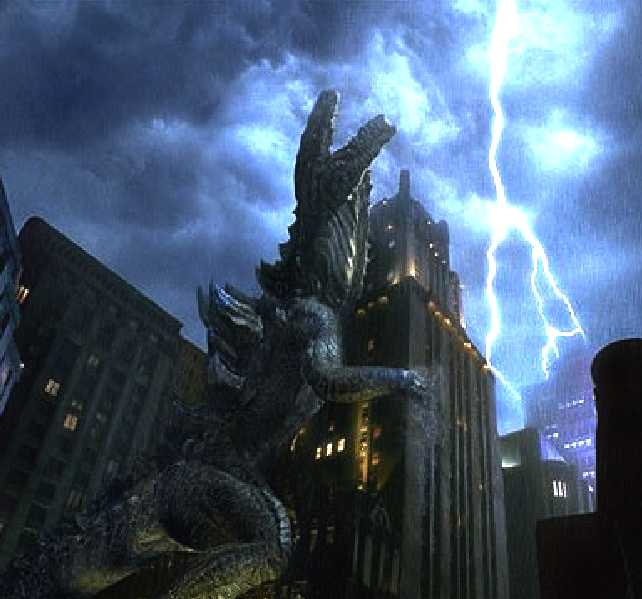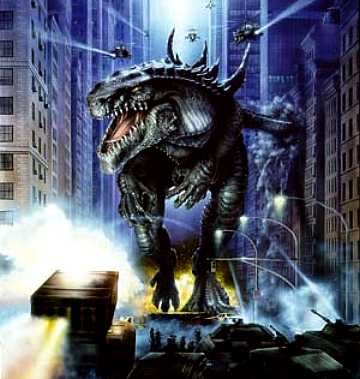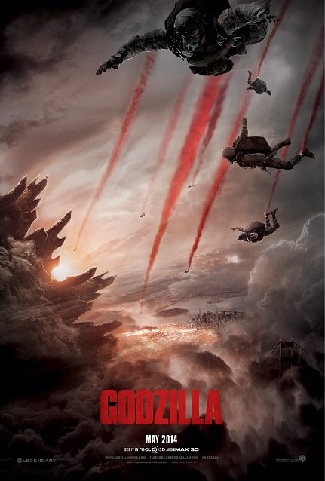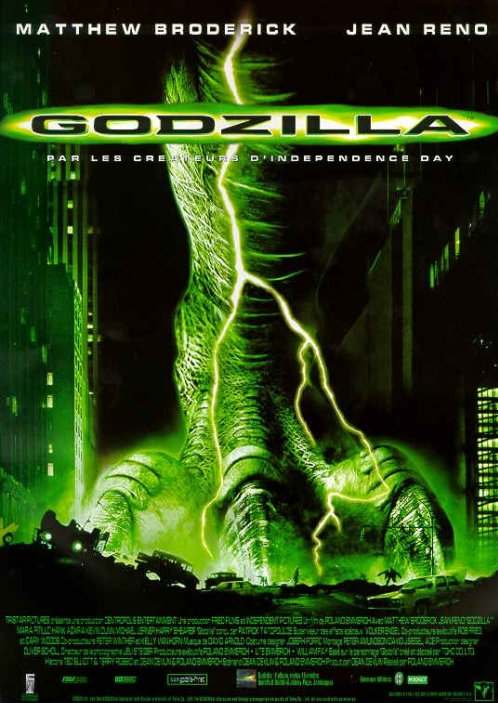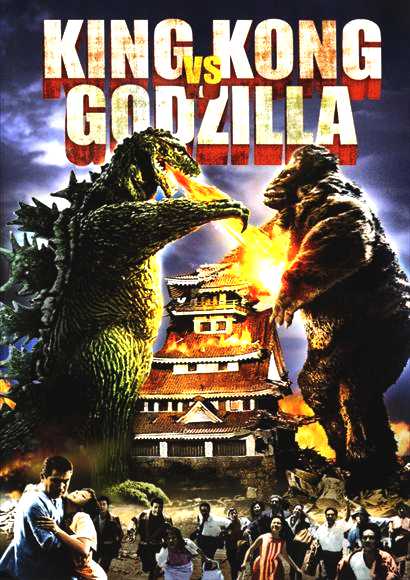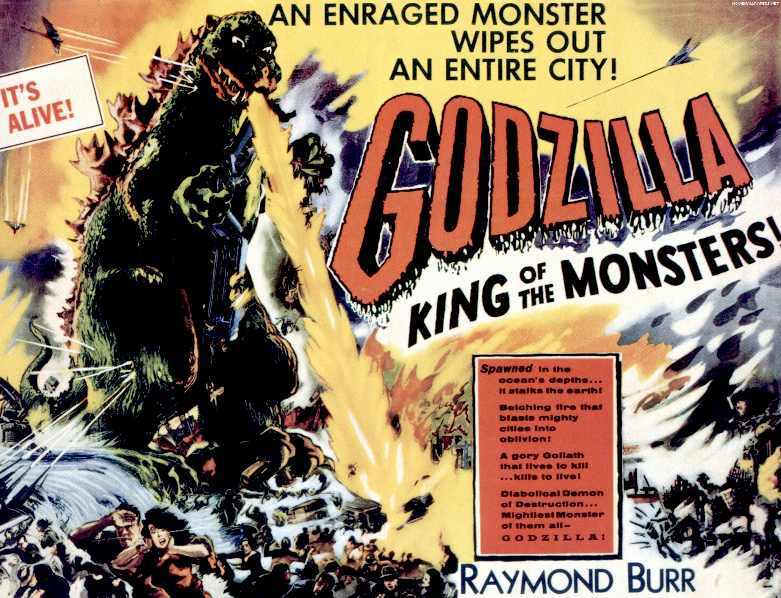|
|
||||||||||||||||||
|
2014 FILM
Godzilla is the 2nd American science fiction monster film featuring the Japanese film monster of the same name in a reboot of the Godzilla film franchise. It is the second Godzilla film to be fully filmed by an American studio. The film retells the origin of Godzilla in contemporary times as a "terrifying force of nature". The film is directed by Gareth Edwards and stars Aaron Taylor-Johnson, Elizabeth Olsen, Bryan Cranston, Juliette Binoche, David Strathairn, Sally Hawkins, and Ken Watanabe.
PRODUCTION
DEVELOPMENT
After the release of 2004's Godzilla: Final Wars, marking the 50th anniversary of the Godzilla film franchise, Toho announced that it would not produce any films featuring the Godzilla character for ten years. Toho demolished the water stage on its lot used in numerous Godzilla films to stage water scenes. TriStar Pictures, which had made the 1998 Godzilla film and held the rights to American-produced Godzilla movies, let their rights expire in 2003.
GODZILLA 3D
LEGENDARY PRODUCTION
GODZILLA HISTORY
Godzilla
(Gojira) is a Kaiju first appearing in Ishirō Honda's 1954 film Godzilla. Since then, Godzilla has gone on to become a worldwide pop culture icon starring in 28 films produced by Toho
Co. Ltd. The monster has appeared in numerous other media incarnations including video games, novels, comic books, and
television series. A 1998 American
re-imagining was produced and a second American version is currently undergoing post-production. The character is commonly alluded to by the title
King of the Monsters, an epithet first used in the Americanized version of the original 1954 film.
THE NAME
Gojira (ゴジラ?) is a portmanteau of the Japanese words: gorira (ゴリラ?, "gorilla"), and kujira (鯨(クジラ)?, "whale"), which is fitting because in one planning stage, Godzilla was described as "a cross between a gorilla and a
whale", alluding to his size, power and aquatic origin. One popular story is that "Gojira" was actually the nickname of a corpulent stagehand at Toho Studio. The story has not been verified, however,
and in the nearly sixty years since the film's original release, no one claiming to be the rumored employee has ever stepped forward nor have any photographs ever surfaced. Kimi Honda (the widow of Ishiro Honda) always suspected that the man never existed as she mentioned in a 1998 interview, "The backstage boys at Toho loved to joke around with tall stories".
1998 MOVIE
This was/is a well presented version of the genre. Critics need to bear in mind that the story does not have to be deep to be well received by fans. In this case Matthew Broderick was perfectly cast as the scientist lead actor, superbly supported by Jean Reno. The special effects were more than adequate and it is hardly surprising that the film made money. It is watch-able again and again.
The 1998 American sci-fi monster was co-written and directed by Roland Emmerich. It is a re-imagining of the popular Japanese film monster of the same name of course. The screenplay was written by Emmerich and Dean Devlin. The film tells the story of Dr. Niko Tatopoulos, played by Matthew Broderick, who is recruited by the military to help study and destroy a giant, mutant reptile created by French nuclear tests in the South Pacific. The cast also features Maria Pitillo, Hank Azaria, Kevin Dunn and Jean Reno.
The film was a co-production between Centropolis Entertainment and TriStar Pictures. It was commercially distributed by TriStar theatrically, and by Sony Pictures Entertainment for home media. On May 19, 1998, the Original Motion Picture Soundtrack was released Epic Records. It features songs written by several recording artists including The Wallflowers, Rage Against the Machine, Silverchair, and Foo Fighters. The film score was composed and orchestrated by David Arnold.
Godzilla premiered in theaters nationwide in the United States on May 20, 1998 grossing $136,314,294 in domestic ticket receipts. It earned an additional $242,700,000 through international release to top out at a combined $379,014,294 in gross revenue. The film was met with a negative reception from critics and fans alike. The negative reception highlighted by critics included the film's thin plotted script, acting, and directing while fans targeted the film's drastic reinvention of the titular character, which included its radical redesign and departure from the source material. Due to this, the film won and was nominated for multiple Razzie Awards, including Worst Remake or Sequel, but received recognition in the field of computer-generated imagery by winning the Saturn Award for Best Special Effects. Planned sequels were abandoned, however an animated series premiered September 12, 1998 on the Fox Kids network.
1998 MOVIE PLOT
Dr. Niko "Nick" Tatopoulos (Broderick), an NRC scientist, is in the Chernobyl exclusion zone in Ukraine researching the effects of radiation on wildlife, but is suddenly interrupted by the arrival of an official from the U.S. State Department. He is sent to Tahiti and Jamaica, escorted by the military, to observe the wreckage of the recovered Japanese fishing trawler with massive claw marks on it. The Frenchman is also present, observing the scene, and introduces himself as Philippe Roaché (Reno), an insurance agent. Aboard a military aircraft, Dr. Tatopoulos identifies skin samples he discovered in the shipwreck as belonging to an unknown species. He dismisses the military's theory that the creature is a living dinosaur, instead deducing that it is a mutant created by nuclear testing. The large reptilian creature dubbed as "Godzilla" by the media, travels to New York City leaving a path of destruction in its wake. The city is evacuated as the military attempts to kill it but fails in an initial attempt. Dr. Tatopoulos later collects a blood sample and learns that Godzilla reproduces asexually and is collecting food for its offspring. Aspiring journalist and ex-girlfriend of Dr. Tatopoulos, Audrey Timmonds (Pitillo), uncovers a classified tape in his provisional military tent which concerns the origins of the lizard. Her superior Charles Caiman (Shearer) however, declares the tape as his own media discovery. The tape is broadcast on television embarrassing the military on the sensitive nature of the situation. Dr. Tatoen is kidnapped by Roaché, who reveals himself to be an agent of the DGSE, the French foreign intelligence agency. He and his colleagues have been keeping close watch on the events and are planning to cover up their role in the nuclear accident that spawned the creature. Suspecting a nest somewhere in the city, they cooperate with Dr. Tatopoulos to trace and destroy it.
Following a chase with Godzilla, the creature dives into the Hudson River where it is attacked by Navy submarines. After sustaining head-on collisions with torpedoes, the beast sinks after being rendered incapacitated. Believing it is finally dead, the authorities celebrate. Dr. Tatopoulos and Roaché's special operations team, covertly followed by Timmonds and her cameraman Victor "Animal" Palotti (Azaria), make their way through underground subway tunnels to Madison Square Garden. There, they locate numerous eggs, having finally found the nest. As they attempt to destroy them by planting explosives, the eggs suddenly hatch. Sensing the human intruders as food, they begin attacking them. Dr. Tatopoulos, Palotti, Timmonds and Roaché take refuge in the coliseum's broadcast booth and send a live news report to alert the military of what will happen if the lizards escape. A prompt response involving an airstrike is initiated as the four escape moments before the arena is bombed. Godzilla however, survived the torpedo attack earlier underwater and emerges from the venue's ruins. Discovering all of its offspring dead, it roars in anger and chases Dr. Tatopoulos, Roaché, Timmonds and Palotti through the streets of Manhattan. In pursuit of the quartet, Godzilla eventually makes its way to the Brooklyn Bridge. The creature becomes trapped in its steel suspension cables, making it an easy target. After being attacked by military aircraft, it falls to the ground by smashing the cab with its jaw and slowly dies. Meanwhile, amidst the Garden's ruins, a lone egg has survived the aerial bombardment and begins to hatch.
PRODUCTION DEVELOPMENT
In 1992, TriStar Pictures acquired the rights to Godzilla from Toho to produce a trilogy of American Godzilla films, with the promise of "remaining true to the original series – cautioning against nuclear weapons and runaway technology." Screenwriters Ted Elliott and Terry Rossio were tapped to write the script and submitted their final draft in late 1994. Earlier that year, Jan de Bont became attached to direct and began pre-production on the film for a 1996 summer release. De Bont's Godzilla would have had the character's atomic origins discarded and replaced as an artificial creation constructed by Atlantians to fend humanity against a shape shifting extraterrestrial monster called "The Gryphon" and having the final showdown on Ellis Island. Stan Winston and his company were employed to do the effects for the film. Winston crafted sculptures of Godzilla, in vein of the original design, and the rival monster, The Gryphon. De Bont later left the project after TriStar refused to approve his budget of $100-120 million.
Prior to the release of Independence Day, director Roland Emmerich and producer Dean Devlin signed on to do Godzilla under the condition they would be able to handle the film "their way". Emmerich and Devlin discarded Elliott and Rossio's script and provided a new script where the Godzilla character in general was rewritten as a whole. Production began in May 1997, in New York City, and moved to Los Angeles in June.
Patrick Tatopoulos was contacted early on by Emmerich and asked to design the new Godzilla. According to Tatopoulos, the only specific instructions Emmerich gave him was that it should be able to run incredibly fast. Godzilla, originally conceived as a robust, erect-standing, plantigrade reptilian sea monster, was reimagined by Tatopoulos as a lean, digitigrade bipedal iguana that stood with its back and tail parallel to the ground. Godzilla's color scheme was designed to reflect and blend in with the urban environment. At one point, it was planned to use motion capture from a human to create the movements of the computer-generated Godzilla, but it ended up looking too much like a human in a suit.
1998 MOVIE CAST
Matthew Broderick as Dr. Niko "Nick" Tatopoulos
Godzilla premiered in cinemas on May 20, 1998 in wide release throughout the United States for the Memorial Day holiday weekend. Godzilla was initially projected to break the four-day Memorial Day long weekend opening record of $90 million (set by The Lost World: Jurassic Park a year earlier). Instead grossed $55,726,951 in business showing at 3,310 locations over the 4-day weekend. The film Deep Impact opened in 2nd place during that weekend with $19,381,788 in revenue. The film's revenue dropped by 59% in its second week of release, earning $18,020,444. For that particular weekend, the film remained in 1st place as the romantic drama Hope Floats overtook Deep Impact for 2nd place with $14,210,464 in box office business. During its final week in release, Godzilla opened in 19th place grossing $202,157. For that weekend, Lethal Weapon 4 starring Mel Gibson made its debut, opening in 1st place with $34,048,124 in revenue.[26] Godzilla went on to top out domestically at $136,314,294 in total ticket sales through an 8-week theatrical run. Internationally, the film took in an additional $242,700,000 in business for a combined worldwide total of $379,014,294. For 1998 as a whole, the film was the 9th highest grossing film domestically and the 3rd highest grossing film Worldwide.
CHARACTER DEVELOPMENT
Although the specific details of Godzilla's appearance have varied slightly over the years, the overall impression has remained consistent. Inspired by the fictional Rhedosaurus created by animator Ray Harryhausen for the film The Beast from 20,000 Fathoms, Godzilla's iconic character design was conceived as that of an amphibious reptilian monster based around the loose concept of a dinosaur with an erect standing posture, scaly skin, an anthropomorphic torso with muscular arms, spikes on its back and tail, and a furrowed brow. Art director Akira Watanabe combined attributes of a Tyrannosaurus, an Iguanodon, a Stegosaurus and an alligator to form a sort of blended chimera, inspired by illustrations from an issue of Life magazine. To emphasise the monster's relationship with the atomic bomb, its skin texture was inspired by the keloid scars seen on Hiroshima's survivors.
Godzilla's appearance has traditionally been portrayed in the films by an actor wearing a latex costume, though the character has also been rendered in animatronic, stop-motion and computer-generated form. Godzilla has a distinctive roar, which was created by composer Akira Ifukube, who produced the sound by rubbing a resin coated glove along the string of a contrabass and then slowing down the playback. Godzilla is sometimes depicted as green in comics, cartoons and movie posters, but the costumes used in the movies were usually painted charcoal grey with bone-white dorsal fins up until the film Godzilla 2000.
Within the context of the films, Godzilla's exact origins vary, but it is generally depicted as an enormous, violent, prehistoric sea monster awakened and empowered by nuclear radiation. Its size is inconsistent, changing from film to film and even from scene to scene for the sake of artistic license. The miniature sets and costumes are typically built at a 1/25 - 1/50 scale and filmed at 240 frames per second, to create the illusion of great size. Supplementary information such as character profiles depict Godzilla as being 50–100 meters (164–328 feet) tall and weighing 20-60,000 tons. Godzilla's signature weapon is its "atomic breath," a nuclear blast that it generates inside of its body and unleashes from its jaws in the form of a blue or red radioactive heat ray. Toho’s special effects department has used various techniques to render the breath, from physical gas-powered flames to hand-drawn or computer-generated fire. Godzilla is shown to possess immense physical strength and muscularity. Haruo Nakajima, the actor who played Godzilla in the original films, was a black belt in Judo and used his expertise to choreograph the battle sequences.
Godzilla can breathe underwater, and described in the original film by the character Dr. Yamane as a transitional form between a marine and a terrestrial reptile. Godzilla is shown to have great vitality: it is immune to conventional weaponry thanks to its rugged hide and ability to regenerate, and as a result of surviving a nuclear explosion, it cannot be destroyed by anything less powerful. Various films, television shows, comics and games have depicted Godzilla with additional powers such as an atomic pulse, magnetism, precognition, fireballs, an electric bite, superhuman speed, eye beams and even flight.
Godzilla's allegiance and motivations have changed from film to film to suit the needs of the story. Although Godzilla does not like humans, it will fight alongside humanity against common threats. However, it makes no special effort to protect human life or property and will turn against its human allies on a whim. It is not motivated to attack by predatory instinct: it doesn't eat people, and instead sustains itself on radiation and an omnivorous diet. When inquired if Godzilla was "good or bad", producer Shogo Tomiyama likened it to a Shinto "God of Destruction" which lacks moral agency and cannot be held to human standards of good and evil. "He totally destroys everything and then there is a rebirth. Something new and fresh can begin."
The gender of the Godzilla character has been a subject of confusion for English-speaking audiences. In the original Japanese films, Godzilla and all the other monsters are referred to with gender-neutral pronouns such as "it", while in the English dubbed versions, Godzilla is explicitly described as a male, such as in the title of Godzilla, King of the Monsters!. The 1998 Hollywood remake contributed to this confusion, in which the titular character (subsequently known as Zilla) was depicted laying eggs.
In the various stories it has appeared in, Godzilla has been featured alongside many supporting characters. It has faced human opponents such as the JSDF, and giant other monsters, from recurring characters like King Ghidorah, Gigan and Mechagodzilla to one-shot characters like Megalon, Biollante and Megaguirus. Godzilla is also shown to have allies, such as Mothra, Rodan and Anguirus (though these characters were initially portrayed as Godzilla's rivals), and children, such as Minilla. Godzilla has even fought against fictional characters from other franchises in crossover media, such as King Kong and the Fantastic Four.
WORLDWIDE CULTURAL IMPACT
Godzilla is one of the most recognizable symbols of Japanese popular culture worldwide and remains an important facet of Japanese films, embodying the kaiju subset of the tokusatsu genre. Godzilla’s vaguely humanoid appearance and strained, lumbering movements endeared it to Japanese audiences, who could relate to Godzilla as a sympathetic character despite its wrathful nature.
Audiences respond positively to the character because it acts out of rage and self-preservation and shows where science and technology can go wrong. Godzilla has been considered a filmographic metaphor for the United States, as well as an allegory of nuclear weapons in general. The earlier Godzilla films, especially the original, portrayed Godzilla as a frightening, nuclear monster. Godzilla represented the fears that many Japanese held about the nuclear attacks on Hiroshima and Nagasaki, and the possibility of recurrence.
As the series progressed, so did Godzilla, changing into a less destructive and more heroic character as the films became geared towards children. Since then, the character has fallen somewhere in the middle, sometimes portrayed as a protector of the world from external threats and other times as a bringer of destruction. Godzilla remains one of the greatest fictional heroes in the history of film, and is also the second of only three fictional characters to have won the MTV Lifetime Achievement Award, which was awarded in 1996. Godzilla was given a star on the Hollywood Walk of Fame in 2004 to celebrate the premiere of the character's 50th anniversary film, Godzilla: Final Wars. Godzilla's pop-cultural impact has led to the creation of numerous parodies and tributes, as seen in media such as Bambi Meets Godzilla, which was ranked as one of the "50 greatest cartoons", various episodes of Mystery Science Theater 3000, and the song "Godzilla", by Blue Öyster Cult. Godzilla has also been used in advertisements, such as in a commercial for Nike, where Godzilla lost a game of basketball to NBA player Charles Barkley. The commercial was subsequently adapted into a comic book illustrated by Jeff Butler. Godzilla's success inspired the creation of numerous other monster characters, such as Gamera, Yonggary and Gorgo.
Godzilla's fame and saurian appearance has had an impact on the scientific community. Gojirasaurus is a dubious genus of coelophysid dinosaur, named by paleontologist and admitted Godzilla fan Kenneth Carpenter. Dakosaurus is an extinct marine crocodile of the Jurassic Period, which researchers informally nicknamed "Godzilla". Paleontologists have written tongue-in-cheek speculative articles about Godzilla's biology, with Ken Carpenter tentatively classifying it as a ceratosaur based on its skull shape, four fingered hands and dorsal scutes, and paleontologist Darren Naish expressing skepticism while commenting on Godzilla's unusual morphology.
Godzilla's ubiquity in pop-culture has led to the mistaken assumption that the character is in the public domain, resulting in litigation by Toho to protect their corporate asset from becoming a generic trademark. In April 2008, Subway depicted a giant monster in a commercial for their Five Dollar Footlong sandwich promotion. Toho filed a lawsuit against Subway for copyright infringement, demanding $150,000 in compensation. In February 2011, Toho sued Honda for depicting a fire-breathing monster in a commercial for the Honda Odyssey. The monster was never mentioned by name, being seen briefly on a video screen inside the minivan. The Sea Shepherd Conservation Society christened a vessel Gojira. Its purpose is to target and harass Japanese whalers in defense of whales in the Southern Ocean Whale Sanctuary. The Gojira was renamed MV Brigitte Bardot in May 2011 after complaints of copyright infringement by Toho. Gojira is the name of a French death metal band, formerly known as Godzilla; legal problems forced the band to change their name.
A - Z FILMS INDEX
A - Z ACTORS INDEX
An all action Sci-fi adventure which begins in Antarctica when scientists discover an extinct species of giant insect, then try to bring the eggs back to civilization to be the first to claim the find.
|
||||||||||||||||||
|
This website is Copyright © 2014 Max Energy Limited - an educational charity working hard to protect the planet. |
||||||||||||||||||
|
|
